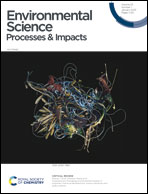Extracellular polymeric substances enhance dissolution and microbial methylation of mercury sulfide minerals†
Abstract
Due to the extremely low solubility, mercury sulfide minerals, as the major environmental mercury sinks, are generally considered to be inert mercury species with minimal bioavailability. Here, we demonstrate that extracellular polymeric substances (EPS), continuously secreted and released by anaerobic methylating bacteria, enhance the dissolution processes of cinnabar (α-HgS) minerals. The enhancing effects of EPS occur to a greater extent in the dissolution of nanoparticulate α-HgS compared to the bulk-scale counterpart. The released EPS–Hg(II) species are available for microbial methylation to produce bioaccumulative neurotoxin, methylmercury. This is probably due to the abundant aromatic proteins in EPS that strongly interact with surface Hg(II) via inner-sphere complexation as well as cation–π interaction. Our study discovers the potential environmental risks of “inert” mercury sulfide minerals in natural microbial habitats, particularly benthic biofilms with abundant microbial EPS, transformed to the severely toxic methylmercury. The mechanistic findings will facilitate an accurate understanding of the interactions between soft and transition metals and microorganism-derived organics, which may dictate the environmental fate and impact of these elements.

- This article is part of the themed collection: Biogeochemistry of the Trace Elements


 Please wait while we load your content...
Please wait while we load your content...